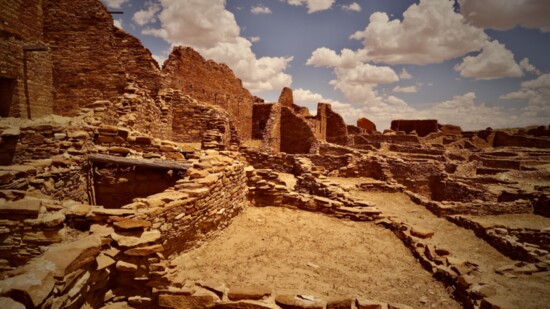From A.D. 850–1150, roughly 1,000 years ago, Chaco Canyon was the center of a community that extended throughout the modern Four Corners region. Over the span of several hundred years, Ancestral Pueblo peoples constructed 13 great houses and hundreds of small houses in the canyon. Archaeologists cannot say exactly what took place here, but evidence of trade, ceremony, and farming points towards a thriving cultural center and pilgrimage site.
Around A.D. 1050, inhabitants of Chaco Canyon began to move north to build the Aztec community. Aztec West, East, and North are a group of great houses constructed along the Animas River that archaeologists believe Ancestral Pueblo peoples intended to be the next “center” of Chacoan culture.
Just a short drive from Albuquerque, two national parks now encompass parts of these Ancestral communities and much more. Chaco Culture National Historical Park was dedicated in 1907, and Aztec Ruins National Monument in 1923, to ensure the preservation of these places for generations to come. These national parks are designated UNESCO World Heritage Sites that safeguard thousands of archaeological resources. Ensuring the preservation of these parks means securing an enormous amount of support, and the Chaco Culture Conservancy (CCC) is on a mission to do just that.
The Chaco Culture Conservancy was formed in 2020 to provide philanthropic support to Chaco Culture National Historical Park and Aztec Ruins National Monument. We work to inspire people to support, connect with, and learn about these parks- through philanthropy and volunteer activities – thus ensuring the preservation of the Chacoan architectural landscapes, natural resources, and cultural heritage for present and future generations.
Philanthropic support is much more than a donation to supporting park projects; it strengthens the bonds between parks and their advocates. The legacy of philanthropy in national parks began even before the National Park Service was formed in 1916. Today, you have an opportunity to be a part of that legacy. Congress funds the parks’ budget, and your support stretches those dollars further. Gifts made to the CCC contribute to park projects and programs in three categories: Trails, Preservation, and Access.
Trails
Ancestral peoples built extensive road systems throughout the Southwest, many of which led back to Chaco Canyon. Visiting Chaco Culture National Historical Park today, you may even see original road segments and stairways built by Ancestral Pueblo peoples. During your visit to both parks, you’ll also access over 30 miles of modern trails that can connect you to the past. Whether taking a walk through Aztec West or scaling the side of a mesa to see the iconic Pueblo Bonito viewpoint, hiking trails are an important part of your national park experiences.
With over 65,000 visitors each year, the effects of visitor use, natural degradations, and climate change mean that the dedicated staff at these parks must work hard to ensure trails stay safe and accessible. These trails require routine maintenance, resurfacing, invasive plant removal, and realignment. Since 2021, the CCC has invested over $20,000 in projects to improve and enhance trails around both parks.
Preservation
Over a thousand years ago the individuals tasked with building Pueblo Bonito, Casa Rinconada, and Chetro Ketl did not use metals, plastics, or polyester fibers. They constructed these massive structures using sandstone, natural mortar, and wooden beams. Today the National Park Service is dedicated to preserve these places.
The CCC has supported their work by funding analysis when sites have been backfilled for protection purposes, preservation interns to learn the craft of generations before, and Lidar scanning to map structures at risk of being lost to climate change. By investing nearly $30,000 in projects that ensure the preservation of objects, historical documents, and architecture at both parks, the CCC and our donors are helping ensure the lasting legacy of preservation.
Access
Once a year the beat of a drum and the jingle of bells can again be heard in the East Plaza of Pueblo Bonito. On the Summer Solstice, the National Park Service often hosts Indigenous dance groups to perform on the same sacred ground as their ancestors. Throughout the year, both parks host many diverse Indigenous communities into the parks to share their cultural heritage and knowledge through lectures, dances, and demonstrations.
For the last four years, the CCC has funded over $46,000 in projects that promote access to these national parks. This includes visitor access to WiFi at Chaco Culture National Historical Park, access to educational audio tours at Aztec Ruins National Monument, and the access of Indigenous speakers, demonstrators, and lecturers to these national parks. By funding projects that focus on access the CCC is proud to support the safety, education, and cultural experiences of visitors.
The CCC is committed to supporting the National Park Service at Aztec Ruins National Monument and Chaco Culture National Historical Park. By investing in trails, preservation, and access projects, we help our donors build their lasting legacy as stewards of their public lands.
To learn more about how you can be a part of our philanthropic community or to make a contribution, visit chacoculture.org
If you are interested in speaking with us about funding specific projects that you are passionate about, please reach out to our Executive Director, Olivia Thomsen at director@chacoculture.org
Archaeologists cannot say exactly what took place here.
Ancestral peoples built extensive road systems throughout the Southwest, many of which led back to Chaco Canyon.
